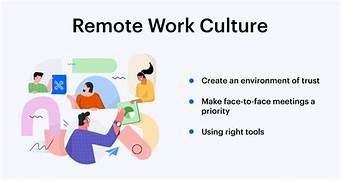How Remote Work Culture Reshapes Organizational Management
Remote work culture has become a defining feature of the modern workplace, driven by advancements in technology and catalyzed by the global shift during the COVID-19 pandemic. As organizations increasingly embrace remote work, they are rethinking traditional management approaches to accommodate the unique challenges and opportunities of a distributed workforce. This transformation goes beyond logistical adjustments, impacting leadership styles, communication strategies, employee engagement, and organizational policies.
This article explores how remote work culture reshapes organizational management and provides insights into best practices for navigating this new paradigm.
1. Redefining Leadership in a Remote Environment
Remote work has transformed the role of leaders from task managers to facilitators and enablers. Leaders now focus more on outcomes rather than micromanaging daily activities, trusting employees to manage their responsibilities independently. The shift to a results-oriented approach requires the following adjustments:
- Emphasizing Empathy: Leaders need to be attuned to the personal and professional challenges their team members face. Understanding individual circumstances helps foster a supportive work environment.
- Clear Goal-Setting: In the absence of face-to-face supervision, clearly defined objectives and expectations become critical to maintaining productivity and accountability.
- Promoting Autonomy: Encouraging employees to take ownership of their tasks helps build trust and boosts morale, especially when physical supervision isn’t feasible.
2. Transforming Communication Practices
Effective communication is the backbone of remote work culture, yet the absence of physical proximity introduces challenges such as misinterpretation and isolation. Organizations must adopt new communication norms and tools to bridge this gap.
- Adopting Digital Tools: Platforms like Zoom, Slack, and Microsoft Teams have become integral to maintaining seamless communication. Companies must ensure these tools are user-friendly and accessible to all employees.
- Encouraging Transparency: Regular updates, virtual town halls, and open-door policies foster transparency and keep employees informed about organizational changes.
- Balancing Synchronous and Asynchronous Communication: While real-time discussions are essential for collaboration, asynchronous communication accommodates employees in different time zones or with varying schedules.
3. Reimagining Collaboration and Teamwork
Collaboration in remote settings requires intentional effort to replicate the spontaneity of in-office interactions. Organizations must invest in tools and strategies to enable teamwork and maintain a sense of community.
- Virtual Brainstorming Sessions: Using collaborative tools like Miro or Google Workspace allows teams to ideate effectively in a digital environment.
- Fostering a Sense of Belonging: Virtual team-building activities and informal gatherings help maintain camaraderie and reduce feelings of isolation.
- Project Management Software: Tools like Trello, Asana, or Monday.com streamline task allocation and tracking, ensuring that teams stay on the same page.
4. Addressing Employee Well-Being
Remote work blurs the boundaries between personal and professional life, making it essential for organizations to prioritize employee well-being. This shift requires a holistic approach:
- Encouraging Work-Life Balance: Flexible schedules and clear boundaries prevent burnout and allow employees to recharge.
- Providing Mental Health Support: Offering resources such as counseling services, wellness programs, and mental health days demonstrates a commitment to employee well-being.
- Recognizing Achievements: Regular acknowledgment of contributions, whether through virtual awards or shout-outs during meetings, boosts morale and fosters a positive work culture.
5. Revising Performance Evaluation Metrics
Traditional performance metrics based on office attendance and visible effort are no longer applicable in a remote setting. Organizations need to shift to more outcome-based evaluation methods.
- Focusing on Deliverables: Measuring success by completed tasks and achieved objectives provides a fair assessment of employee performance.
- Incorporating Regular Check-Ins: One-on-one virtual meetings allow managers to provide constructive feedback and support while staying aligned with employee progress.
- Encouraging Self-Assessment: Inviting employees to evaluate their own performance fosters self-awareness and accountability.
6. Leveraging Technology for Remote Work Management
Technology plays a pivotal role in the success of remote work. Organizations must adopt tools that enhance productivity, communication, and security.
- Cloud-Based Solutions: Cloud platforms ensure that employees can access necessary resources and files from anywhere.
- Cybersecurity Measures: Protecting sensitive information in a remote setting requires robust security protocols and training for employees.
- Data Analytics: Leveraging analytics tools provides insights into productivity trends and helps identify areas for improvement.
7. Cultivating a Remote-First Mindset
As remote work becomes a permanent fixture for many organizations, a remote-first mindset ensures that policies and practices cater to all employees, regardless of location.
- Equal Opportunities: Ensuring that remote workers have access to the same growth opportunities as in-office employees prevents inequality.
- Inclusive Leadership: Leaders must be trained to manage diverse teams spread across various locations and cultural backgrounds.
- Hybrid Models: Offering flexible arrangements that combine remote and in-office work provides the best of both worlds, accommodating different employee preferences.
8. Adapting Organizational Culture
Remote work challenges traditional organizational culture, requiring companies to redefine their values and practices to align with the new normal.
- Promoting Inclusivity: Embracing diversity and fostering an inclusive culture ensures that remote teams feel valued and respected.
- Encouraging Innovation: Providing employees with the freedom to experiment and innovate fosters creativity and drives organizational growth.
- Documenting Processes: Clear documentation of workflows and policies helps maintain consistency and reduces confusion in remote settings.
9. The Challenges of Remote Work Management
Despite its benefits, remote work poses several challenges that organizations must address:
- Employee Isolation: Prolonged remote work can lead to feelings of disconnection and loneliness, impacting mental health and productivity.
- Technology Fatigue: Overreliance on digital tools can cause burnout and reduce engagement.
- Inequality in Resources: Not all employees have access to reliable internet or comfortable workspaces, creating disparities in productivity.
Organizations must proactively address these issues to ensure the sustainability of remote work.
Conclusion
Remote work culture has fundamentally reshaped organizational management, requiring leaders to adapt to new ways of thinking and operating. By focusing on empathy, communication, collaboration, and well-being, organizations can create a thriving remote work environment. Embracing technology and cultivating a remote-first mindset will position businesses to succeed in an increasingly distributed world. As remote work continues to evolve, organizations that prioritize flexibility, inclusivity, and innovation will remain at the forefront of this transformative shift.


